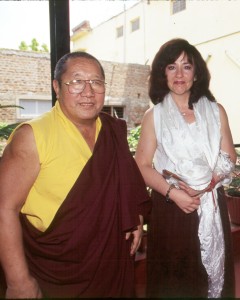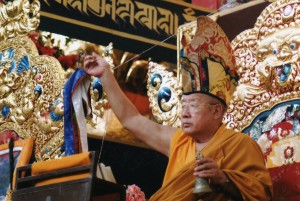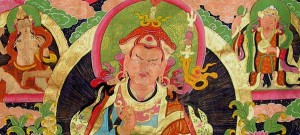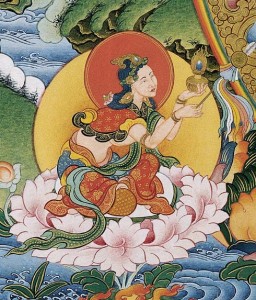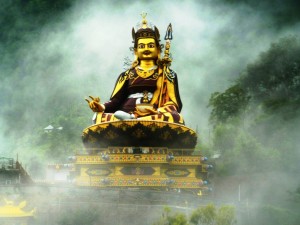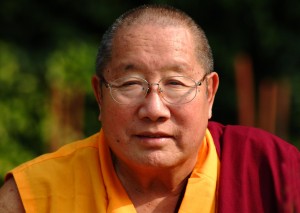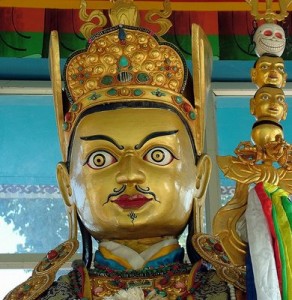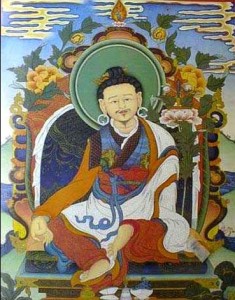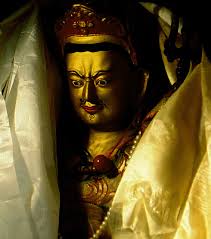An excerpt from the Mindfulness workshop given by Jetsunma Ahkon Lhamo in 1999
Another aspect of constant mindfulness – it’s sort of like hand-in-glove with offering – is gratitude. When you think about the appearance of all phenomena, like beautiful flowers, beautiful trees, all of our beautiful stuff, suppose you were able to develop the habit of thinking like this: “How great must be the Buddha nature, that this display of the Buddha nature is so beautiful,” with gratefulness. It’s not like ‘thank-you-God-for-everything.’ It’s not like that. It’s a deep response, joyfulness, the Recognition to see that the nature that is our deepest, most profound nature, the nature that is all-pervasive, the nature that is our Buddha nature is actually inherent in all appearances. To acknowledge that, to move into any kind of Recognition of that is so amazing. To think that we are somehow connected. How amazing!
A sense of wonder that encourages you, not just to see and react in a dull and stupid way, but to perceive more deeply. By doing that, we develop the habit of letting the mind be more profound, letting the mind reach its depth, and consequently, one’s practice becomes so much more profound and our level of Recognition becomes so much more deepened. This sense of gratitude ultimately, as we begin to practice, gives rise to an awareness of the emptiness of all phenomena and the inherent nature that is the heart of all phenomena.
As we begin to think like that, every time we take beauty into our eyes and have the opportunity to offer that beauty, perhaps we can say, “That is Guru Rinpoche’s. This is Guru Rinpoche speaking to me. I see this beauty and now I have, because of that, the opportunity to offer this beauty to the Buddhas and the bodhisattvas for the liberation and the salvation of all sentient beings.” If you have a marvelous personal experience and remember to offer the joy of that experience for the sake of sentient beings, or to the Buddhas and the bodhisattvas, to be able to do that, in that moment, you are with Guru Rinpoche. Guru Rinpoche is speaking to you.
If we learn to Recognize the intrinsic nature of phenomena, isn’t that like learning to see the face of the guru? What’s important about this is the power that we have to practice this way. In ordinary situations, if you love somebody, they can be taken away from you. They themselves can walk away from you. You could lose them. But in this way of thinking, this kind of practice of mindfulness, no one can ever take the appearance of Guru Rinpoche away from you. No one can ever take from you, nothing on this earth has the power to hide from you, to keep from you, the face of the guru. So if you’re able to look at your environment, and think, “Oh, this is so beautiful, such a beautiful place,” and you’re able to really offer it and feel that blissfulness of just letting go and surrendering all the beauty that you see to the Buddhas and the bodhisattvas, praying fervently that somehow that virtue will be used to benefit beings, praying that all of that virtue will go to nourish sentient beings, at that moment, you are in the very arms of the guru. You are not separate from the guru.
In ordinary relationships, someone can take that away from you. Samsara has that power, and there’s not a thing you can do about it. How amazing to distinguish between that and the extraordinary relationship that is brought about through mindfulness and Recognition: this one relationship that nobody on this earth, even Guru Rinpoche himself, could take away from you, not that he’d want to. We have this extraordinary opportunity.
Regarding recognition and mindfulness in our Guru Yoga, remember how I’ve taught you that ultimately the practice of Guru Yoga helps us to recognize our own nature, to recognize our primordial wisdom nature as being inseparable from the teacher? How amazing to use this practice of Recognition in such a way as to expedite all of that and make it so much more profound and so much more meaningful instead of reacting constantly as we habitually do. How amazing if even once, twice, three times in one day, in one week, we can practice that Recognition and remove ourselves from that neurotic scenario, using the appearance of phenomena and our reaction to it as a way to see the face of the guru. How amazing!
© Jetsunma Ahkön Lhamo
